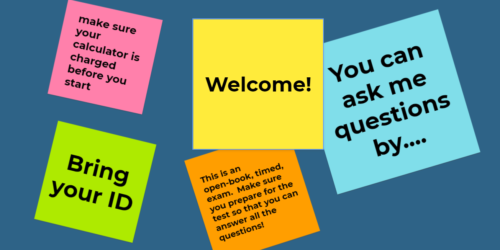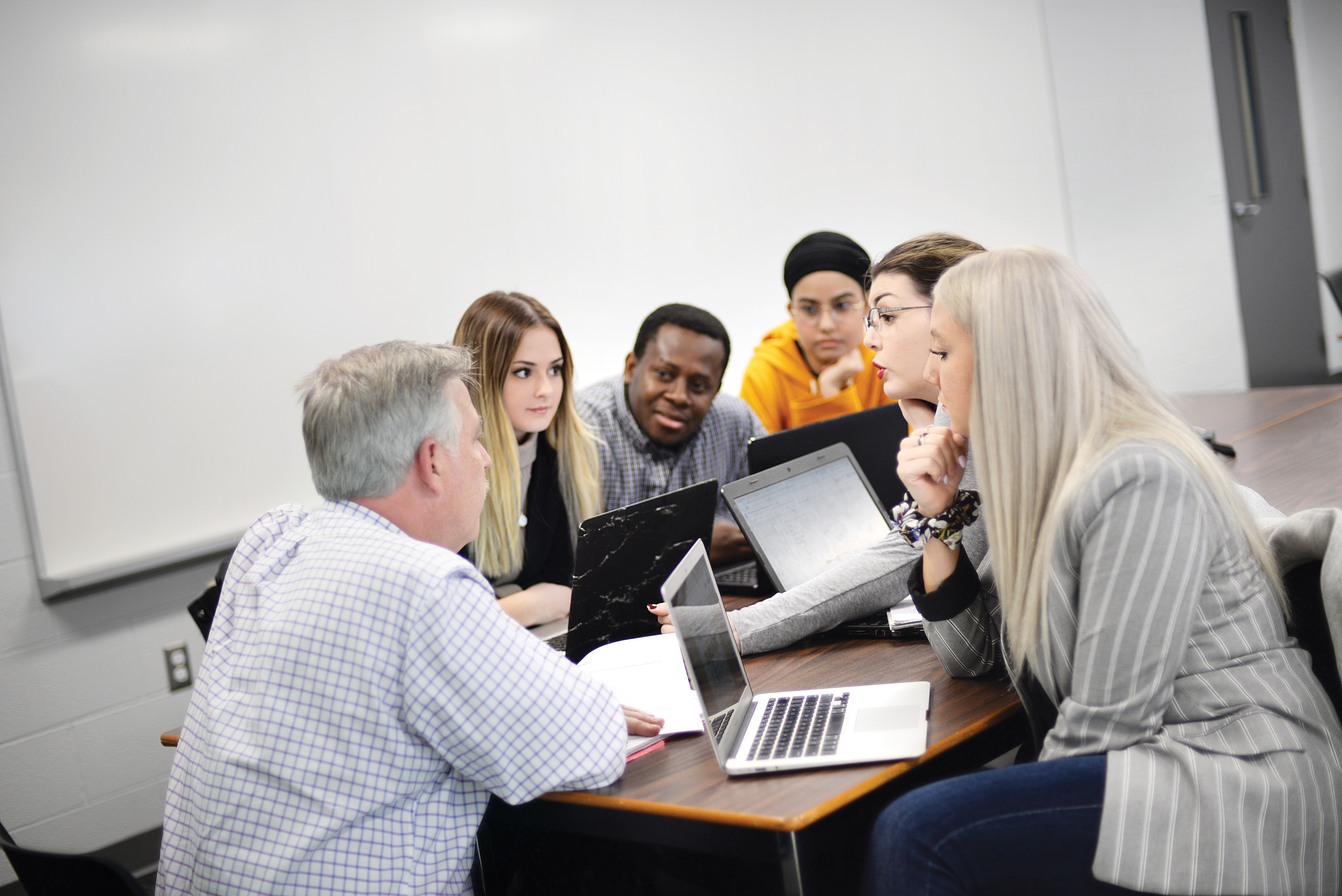
Managing Unexpected and/or Emotional Incidents in Post-Secondary Teaching
During our careers as faculty, we may come across a few unexpected and/or emotional incidents in post-secondary teaching. How do we, for example, navigate a class discussion when students are visibly distraught after just hearing upsetting local or global news, such as the murder of a Muslim family in London, Ontario? Or, what do we say when a student discloses to us during office hours that they just had a miscarriage? These incidents can range from medical emergencies (e.g., a student vomits during an in-person lesson) to mental health crises (e.g., student cries or yells during a group discussion). They can range from major incidents (e.g., a student has an epileptic seizure in an in-person lesson) to more minor incidents (e.g., student falls asleep and is snoring in class).
These incidents are seldom, but when they do occur, it can make faculty uncomfortable and uncertain of how to respond. Whether the incident occurs in a group-setting (i.e., in front of other students either in an online synchronous session or an in-person class), in a one-to-one online or in-person meeting with a student, or over email, faculty need to balance managing their responses to students with their own personal reactions and responses to the situation.
In this post, we will discuss the complex and delicate situations that can arise when teaching. More specifically, we will discuss what we, as faculty, can do when faced with unexpected and/or emotional incidents.
Please note that some of the examples throughout this post can be distressing and overwhelming. Please take your time in reading and exploring this topic. Our intention here is not to overwhelm faculty, but to provide a resource, some tips, and a forum to begin thinking about such incidents and how best to respond.
Unexpected and/or Emotional Incidents in a Group-Setting
When an incident occurs in a group-setting, for example in an online synchronous session, an online breakout room, or an in-person class, faculty have numerous considerations. Before addressing these considerations, what are some examples of these incidents?
Below is a list of example scenarios that might, on the rare occasion, occur in your online synchronous or in-person class:
- a student disclosure about a traumatic experience (e.g., abuse) to the class
- an individual whom the student has a restraining order against shows up searching for the student (e.g., at an in-person lesson)
- a student appears to be intoxicated when in lesson (online synchronous or in-person class)
- a tragedy or death within a cohort or within a specific field or discipline (e.g., death of a student) is brought up in lesson
- a public tragedy or death(s) that directly or indirectly impact students and gets brought up in lesson (e.g., the discovery of murdered Indigenous children’s bodies at Canadian residential schools)
In many of the above scenarios, faculty may also be distraught with the incident. Thus, in addition to managing our own personal reactions and responses, how do we engage students in a helpful, caring, and supportive way? And, once we’ve resolved the immediate situation appropriately, how do we switch gears and re-orientate the class towards a positive learning environment again? Thinking ahead, how can we ensure the incident doesn’t have negative ongoing impacts on our students and their learning?
Below are some suggested strategies to be taken when an unexpected and/or emotional incident occurs:
- Respond in some way, even if it is just to acknowledge the event: A starting point is to respond, in any way, to the event. Acknowledge that a difficult topic has come up and students might experience discomfort, distress, grief, shock, sadness, etc. Say something like “this is a challenging topic” or “that was unexpected news for many of us”. We know that students feel more supported when faculty simply acknowledge an unexpected or emotional event in the post-secondary classroom (Boysen et al., 2009; Boysen & Vogel, 2009; Willis et al., 2020).
- Stop teaching right away: It is best to stop teaching in the moment by asking the class to take a short (e.g., 10 minutes) break. Encourage students to self-regulate in a way that works for them during this break (i.e., move their body, get a snack, check in with a friend). Say something like “we all just received some unexpected news that is upsetting. Let’s take a short break to reset. Feel free to use this 10-minute break to grab a snack, beverage, move your body, or engage in an activity that supports your needs right now.”
- Make yourself available to support students: During the break and after lesson, make yourself available to support students who may want to talk further. Let students know where you will be if they’d like to stay with you to talk further. Say something like “For those of you who’d like to chat with me or stay in this space, please know that I will remain in this classroom (or zoom session) for the duration of the break. You’re welcome to stay here with me and talk with me if you’d like (or stay in this zoom session with me and private message me if you’d like to talk with me).”
- Validate student experiences and express empathy: Let students know that their reactions and responses to the unexpected and/or emotional event is valid. Let them know that you care and that you are, too, (potentially) impacted by the news/event. Say something like “It’s horrible news and I too feel upset hearing it” or “I understand how that might be upsetting for you” or “I may not know much about this topic, but I’m here to listen” (More Feet on the Ground, n.d.).
- Share Conestoga Student Supports: After the break, at the end of lesson, or at the next lesson (and in a course announcement via email or eConestoga), let students know that there are available supports for them should they choose to reach out. It is best to share these resources via a slide in lesson, or in the eConestoga course shell, as opposed to sharing these resources verbally.
- On-Campus Supports:
- Counselling Services: to schedule an appointment, email counselling@conestogac.on.ca or phone 519-748-5220, ext. 3679
- Off-Campus Supports:
- Here 24/7 (Addictions, mental health, crisis services available 24/7 for Waterloo-Wellington-Dufferin region): call 1-844-437-3247
- Good2Talk (24/7 support for Ontario post-secondary students): call 1-866-925-5454 or text GOOD2TALKON to 686868
- Call 911 or visit local hospital emergency room
- When ready, transition back to the lesson: Once ready, transition students back into the learning mindset. Some strategies to ease students back into learning include: breaking concepts down into manageable chunks, giving students time to process information, and providing clear and concise instructions in auditory and visual form for any tasks (Johnson, 2018; Pate, 2020). For more strategies, check out Trauma Informed Teaching.
Some Other Things to Consider:
- Commenting on unknown circumstances/events: What if you haven’t heard of the incident or don’t know what the students are talking about? In certain cases, such as international news or political events, faculty may not be well-versed in or even know about the topic being discussed by students. In such cases, faculty should be cautious with commenting before knowing more. Faculty could benefit from having the class take a short break, and using that break to learn more about the event (e.g., google the event/incident). Having a better understanding of the event or incident will allow faculty to better respond to discussions and support students through those discussions.
- First-language use of students during emotional incidents: When a difficult situation arises or upsetting news is learned, some students might find it easier to sympathize and relate to each other in their own language. Faculty shouldn’t shut these interactions down. But, as soon as possible, faculty should try to bring students back into the shared classroom community discussion.
- Being aware of non-verbal cues: Faculty should be cognizant of their non-verbal cues and how these are being received by students during unexpected and/or emotional incidents. Take note of your facial expressions, body language, tone and pitch of voice, as well as your overall demeanor. Often times, we don’t notice these parts of the communication process. But, we know that much of the way we communicate is through our non-verbal cues and that our non-verbal cues impact teaching (Bunglowala & Bunglowala, 2015).
- Maintaining professional boundaries: In your role as faculty, you are not expected to (nor should you) be a therapist to students. This is solely the role of mental health professionals, not faculty. In your role as faculty, however, you are expected to show empathy, support students, and direct them to the appropriate student support services at Conestoga. This can include having empathetic conversations with students, providing a space to listen to student concerns, and sharing resources for students to access supports.
- Checking in with the student of concern: In the case where a specific student is of concern (e.g., student shares traumatic experience or a student shows up intoxicated), faculty should privately check in with the student, either during a break or at the end of lesson. Checking in with the student shows the student that you’ve acknowledged the situation and you care. It is also a good time to check to see if the student has access to supports, or they can be encouraged to reach out to Conestoga’s Counselling Services.
- At minimum, direct students to available supports: If you are not comfortable engaging in these forms of conversations with students, for whatever reason, that is alright. At minimum, however, faculty need to offer supports and services to students in distress by referring them to the Conestoga Student Success Services (see above section).
Unexpected and/or Emotional Incidents in a One-to-One Meeting
At rare times, faculty may receive disclosures during office hours or other one-to-one meetings (either in-person or online) with students. A student may become visibly upset and cry, or disclose a traumatic event, or have a medical emergency.
In this scenario, many of the strategies from in-group settings apply. For example, we would acknowledge the event/incident, we would shift to offering support to the student, we would validate student experiences and express empathy, and we’d share Conestoga supports.
What else can we consider in a one-to-one setting? For more strategies for responding to students in a one-to-one setting, see this resource: Best Practices for Faculty to Support Students in Distress or in Crisis – Faculty Learning Hub (tlconestoga.ca)
Unexpected and/or Emotional Incidents Over E-mail
Student disclosures of unexpected information or strong emotions over e-mail can be particularly challenging to navigate because we are missing several other cues (e.g., body language, tone, facial expressions, etc.) that may give us insight into how the student is doing. We are all familiar with the surge of e-mails from students, especially during busy semester periods such as the end-of-semester.
How can we balance professionalism with showing care and concern for students in distress? And how can we navigate this over e-mail?
Much like the above scenarios when the incident occurs in a group or one-to-one setting, similar principles and strategies apply to navigating unexpected and/or emotional incidents in e-mail. To read more about how to respond to unexpected and/or emotional incidents over e-mail, see Reacting and Responding to Student E-mails, Especially During End-of-Semester Stress.
References
Boysen, G. A., & Vogel, D. L. (2009). Bias in the classroom: Types, frequencies, and responses. Teaching of Psychology, 36, 12-17.
Boysen, G. A., Vogel, D. L., Cope, M. A., & Hubbard, A. (2009). Incidents of bias in college classrooms: Instructor and student perceptions. Journal of Diversity in Higher Education, 2, 219-231.
Bunglowala, A. & Bunglowala, A. (2015). Non-verbal communication: An integral part of teaching and learning process. International Journal of Research in Advent Technology (E-ISSN: 2321-9637) Special Issue 1st International Conference on Advent Trends in Engineering, Science and Technology “ICATEST 2015”, 08 March 2015, 371-375.
Johnson, R. (2018). Trauma and learning: Impacts and strategies for adult classroom success. Minne TESOL Journal 34(2), 1-8. Retrieved from http://minnetesoljournal.org/journal-archive/mtj-2018-2/trauma-and-learning-impacts-and-strategies-for-adult-classroom-success/
Pate, C. (2020). Strategies for trauma-Informed distance learning. WestEd.
Willis, L. M., Mehta, D., & Davis, A. (2020). Twelve principles trainees, PIs, departments, and faculties can use to reduce bias and discrimination in STEM. ACS Central Science, 6, 2294-2300.







1 Response